Click image for BBB rating
See our Privacy Policy
cool="cool" width="784" height="10129" border="0" cellpadding="0" cellspacing="0" gridx="16" showgridx="showgridx" usegridx="usegridx" gridy="16" showgridy="showgridy" usegridy="usegridy" bgcolor="#99ccff">
|
|
|
 |
|
|
|
|
|
|
|
Welcome to Spaightwood Galleries, Inc.
120 Main Street, Upton MA 01568-6193
You can follow us on Facebook and Twitter!
We blog regularly on Facebook and announce special events and special sales on both sites.
Dürer's Maundy Thursday: The Last Supper to the Betrayal of Jesus
|
|
|
|
|
|
For Catholics during the middle ages and the Renaissance, the Crucifixion was an ever-recurring event: with each newly-committed human sin, Jesus suffered and died yet again (for an early twentieth-century version of this belief, click here to see Georges Rouault's Miserere 35, "Jésus sera en agonie jusqu'a la fin du monde" / "Jesus will be in agony, even to the end of the world"; the title, significantly, comes from the 17th-century French philosopher Blaise Pascals' Pensées). The image of Christ on the cross is everywhere in Medieval and Renaissance art, yet the use of those images could be suspect. If it was intended merely to raise pathos, the images should be rebuked (as Michelangelo, who himself made some ravishing drawings of the Crucifixion, rebuked the all-too-realstic depictions of the Crucifixion in 15th- and early 16th-century Netherlandish art) and as Protestant iconoclasts in those parts of Germany where Lutheranism triumphed, in the Netherlands, and in England, demonstrated when they attempted to purge their churches of these relics of superstitious adoration. Yet at the same time these lovers of St. Paul's Epistles were also fixated on what was for them the meaning of the Crucifixion and for what we need to learn about ourselves from contemplating it: As St. Paul wrote in his first epistle to the Corinthians, "the message about the cross is foolishness to those who are perishing, but to us who are being saved it is the power of God. For it is written, 'I will destroy the wisdom of the wise, and the discernment of the discerning I will thwart.' Where is the one who is wise? Where is the scribe? Where is the debater of this age? Has not God made foolish the wisdom of the world? For since, in the wisdom of God, the world did not know God through wisdom, God decided, through the foolishness of our proclamation, to save those who believe. For Jews demand signs and Greeks desire wisdom, but we proclaim Christ crucified, a stumbling block to Jews and foolishness to Gentiles, but to those who are the called, both Jews and Greeks, Christ the power of God and the wisdom of God. For God’s foolishness is wiser than human wisdom, and God’s weakness is stronger than human strength. Consider your own call, brothers and sisters: not many of you were wise by human standards, not many were powerful, not many were of noble birth. But God chose what is foolish in the world to shame the wise; God chose what is weak in the world to shame the strong; God chose what is low and despised in the world, things that are not, to reduce to nothing things that are, so that no one might boast in the presence of God. He is the source of your life in Christ Jesus, who became for us wisdom from God, and righteousness and sanctification and redemption, in order that, as it is written, 'Let the one who boasts, boast in the Lord.' (I Corinthians 1: 18-31). In the "fact" of the Crucifixion–for Protestants an act in historical time that happened for a purpose and has fulfilled its purpose–to repair the rent in humanity's relationship with God and thus to accomplish the salvation of those who are called to believe. God, to reconcile man to God, died the death promised in Genesis to those who disobeyed God's command not to eat from the Tree of the Knowledge of Good and Evil and thus enabled eternal life to be restored to those chosen by God. The use of the Cross, for Erasmus, especially in his most popular work, the Encomium Moriae or The Praise of Folly was to force readers to set aside reason and turn to God through faith, something that explains its great popularity in Protestant countries (John Milton in a letter from college to his father tells him that everyone at Cambridge written in the early 1620s is reading the work) contrasts with its presence, post Council of Trent, on the Catholic Index of Forbidden Books.
|
|
|
|
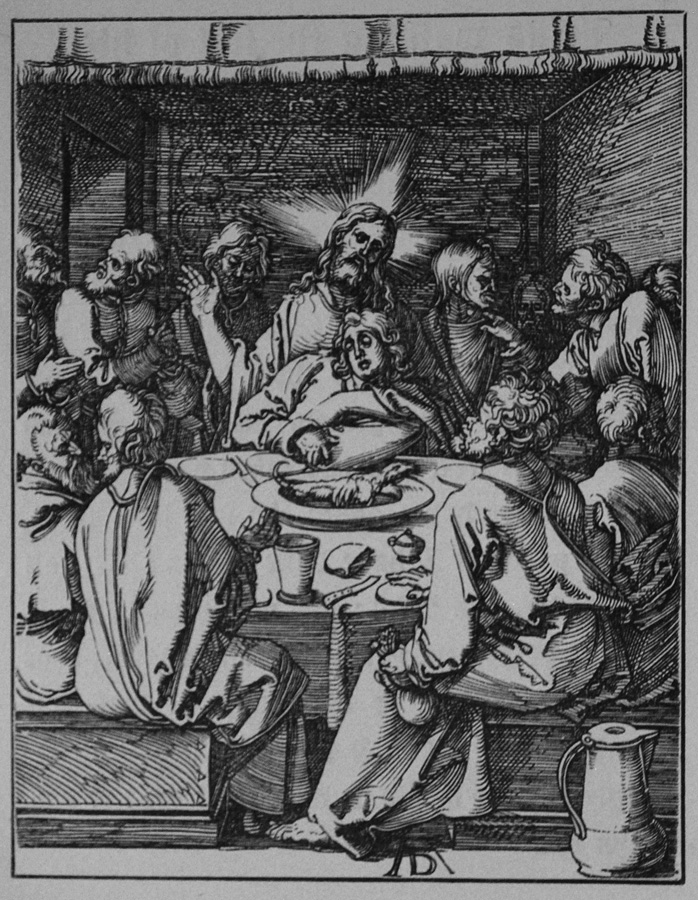 |
|
|
|
|
Albrecht Durer (Nuremburg, 1471-1528), The Last Supper (B. 24, S. 109, Meder 133). Original woodcut, c. 1508-1509. In a room appparently lit by Jesus' glory, our attention is drawn primarily to Jesus, St. John leaning on Jesus, and Judas in the foreground holding the purse by his left knee with his left hand. The apostles are clustered around a round table as opposed to the rectangular table in the Large Woodcut Passion and in The Last Supper of 1523. In 1844 plaster casts were made from Dürer's original woodblocks for the Small Woodcut Passion, which had just been acquired by the British Museum. From these casts, metal plates were made and a small edition produced. Our impression is from this edition. Image size: 127x98mm. Price: Please call or email for current pricing information.
|
|
|
|
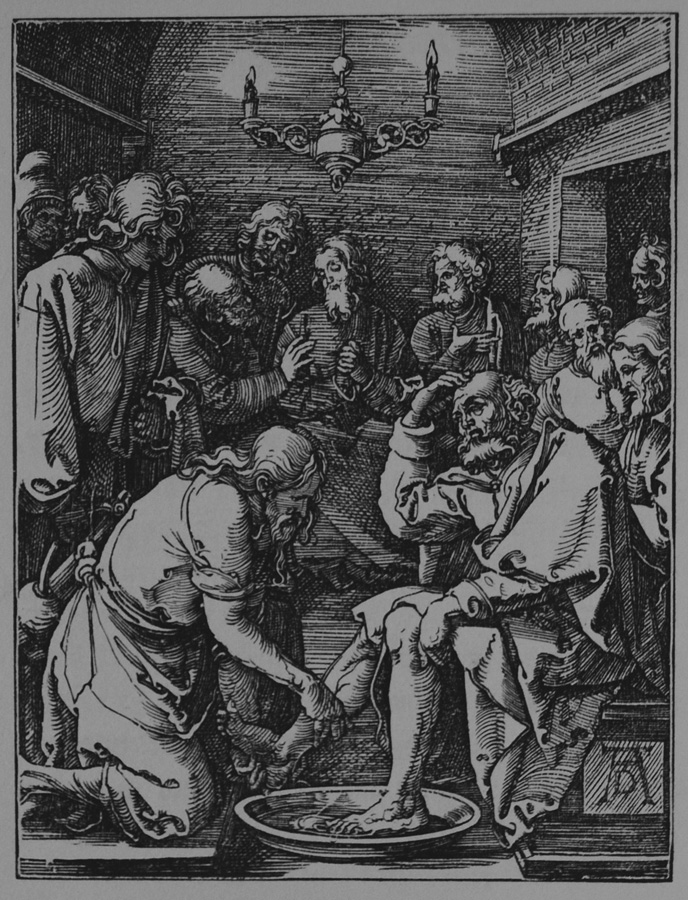 |
|
Albrecht Durer (Nuremburg, 1471-1528), Jesus washing St. Peter's Feet (B. 25, S. 110, Meder 134). Original woodcut, c. 1509-1510 (per Panofsky). The room is now lit only by 2 candles, Judas has already left to betray Jesus (Strauss suggests that the man immediately behind St. John is "not one of the diciples but the innkeeper, St. Peter in the foreground is exceedingly confused, St. John, standing immediately behind Jesus is watching attentively, and the other disciples seem to be talking with each other about what is happening. In 1844 plaster casts were made from Dürer's original woodblocks for the Small Woodcut Passion, which had just been acquired by the British Museum. From these casts, metal plates were made and a small edition produced. Our impression is from this edition. Image size: 127x97mm. Price: Please call or email for current pricing information.
|
|
|
|
|
|
|
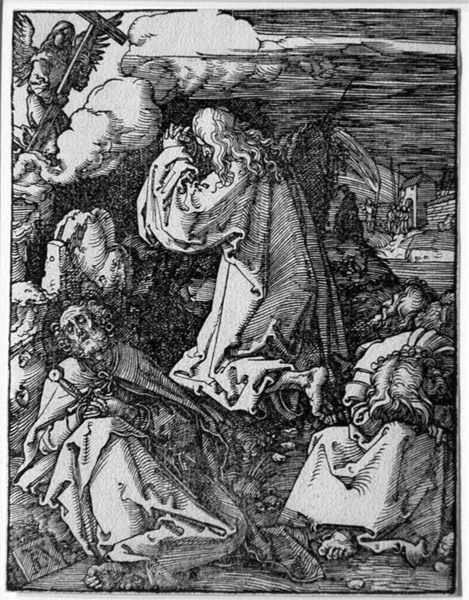 |
|
Albrecht Durer (Nuremburg, 1471-1528), The Agony in the Garden (B. 26, S. 142). Original woodcut, c. 1510. A very good early 16th-century impression on laid paper after the first published edition (no text on verso). The block prints darkly and there is only one small break in the border, top center. Wolfflin calls this the most perfect of the series (see Strauss, p. 414). Strauss notes that "this woodcut has been praised for the realistic rendition of the prayerful attitude of Christ and the sleeping disciples–they actually appear to be asleep, not merely with their eyes closed." Image size: 124x95mm. Price: Please call or email for current pricing information.
|
|
|
|
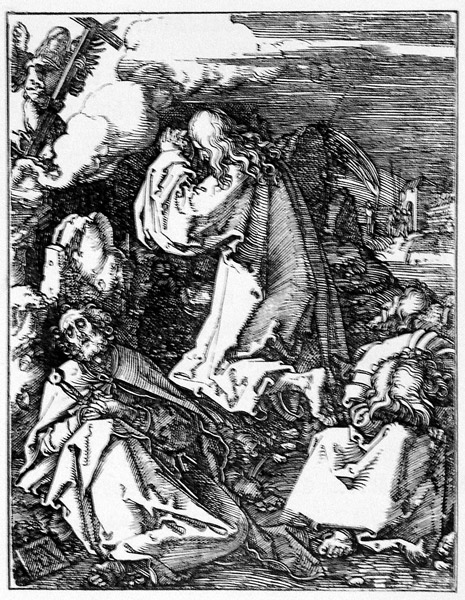 |
|
Albrecht Durer (Nuremburg, 1471-1528), The Agony in the Garden (B. 26, S. 142). Original woodcut, c. 1510. In 1844 plaster casts were made from Dürer's original woodblocks for the Small Woodcut Passion, which had just been acquired by the British Museum. From these casts, metal plates were made and a small edition produced. Our impression is from this edition. Wolfflin calls this the most perfect of the series (see Strauss, p. 414). Strauss notes that "this woodcut hasa been praised for the realistic rendition of the prayerful attitude of Christ and the sleeping disciples–they actually appear to be asleep, not merely with their eyes closed." Image size: 125x96mm. Price: Please call or email for current pricing information.
|
|
|
|
|
|
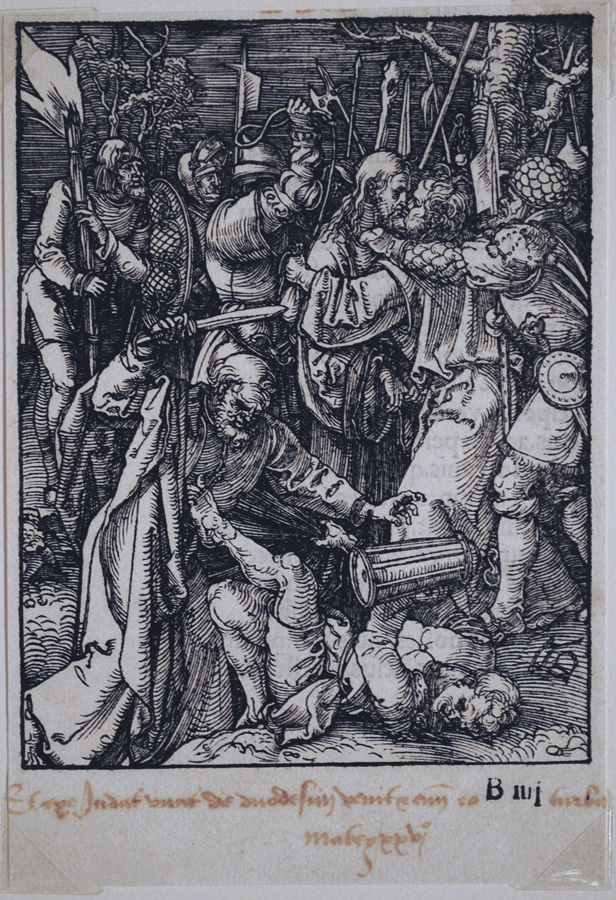 |
|
Albrecht Durer (Nuremburg, 1471-1528), The Betrayal of Christ (B. 27, S. 112, M. 136). Original woodcut, 1509-11. A superb, dark, and well-inked impression from the 1511 book edition with the Latin text on the verso, the first complete publication of the series and the only one with this Latin text on the verso. This rich impression boasts strong contrasts and no sign of wear. Full borders on all sides; annotations in orange ink at bottom; signature Biij as called for in the 1511 book edition. Signed with the monogram lower right. Dürer treated the same subject in his Engraved Passion in 1508 and in the Large Passion in 1510. Image size: 127x95mm. Price: Please call or email for current pricing information.
|
|
|
|
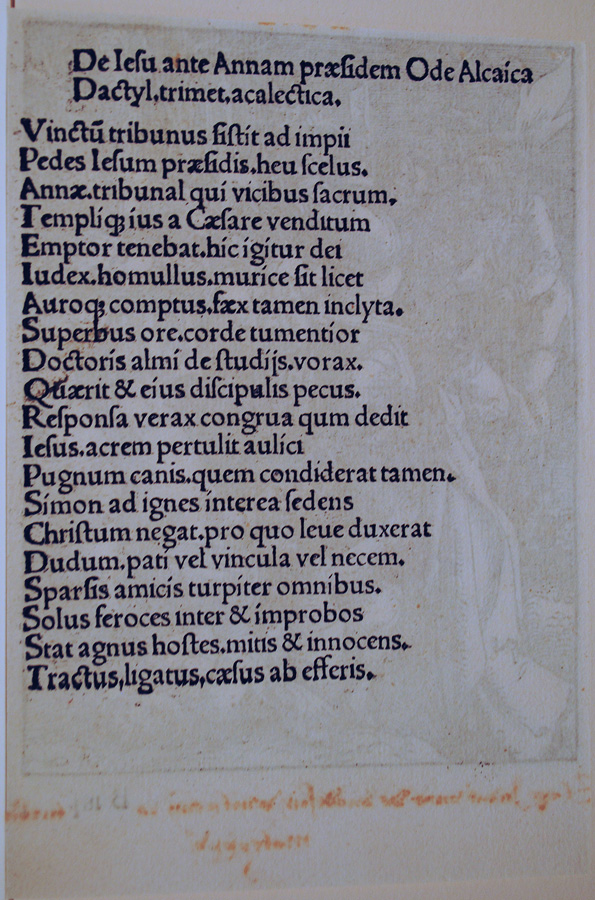 |
|
Albrecht Durer (Nuremburg, 1471-1528), The Betrayal of Christ (B. 27, S. 112, M. 136), verso. Original woodcut, 1509-11. A superb, dark, and well-inked impression from the 1511 book edition with the Latin text on the verso. From the 1511 first edition of the Small Woodcut Passion with verses on the verso by Benedictus Chelidonius. The text relates to the woodcut that follows the Betrayal, Christ before Annas. The text is only to be found in the 1511 edition of the Small Woodcut Passion.
Sorry that the verso was photographed at an angle.
|
|
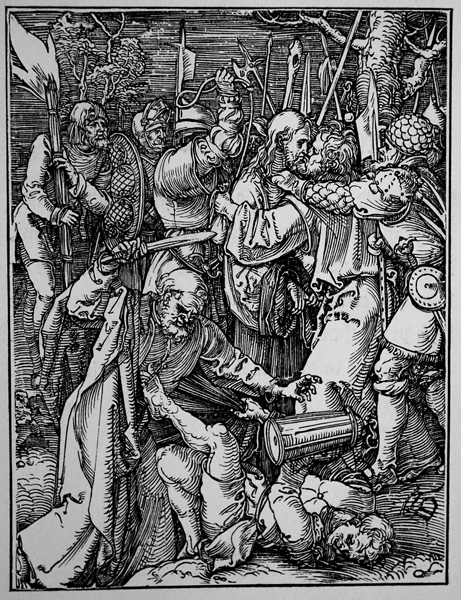 |
|
|
|
|
Albrecht Durer (Nuremburg, 1471-1528), The Betrayal of Christ (B. 27, S. 112). Original woodcut, c. 1509. In 1844 plaster casts were made from Dürer's original woodblocks for the Small Woodcut Passion, which had just been acquired by the British Museum. From these casts, metal plates were made and a small edition produced. Our impression is from this edition. Dürer treated the same subject in his Engraved Passion in 1508 and in the Large Passion in 1510. Image size: 127x95mm. Price: Please call or email for current pricing information.
|
|
|
|
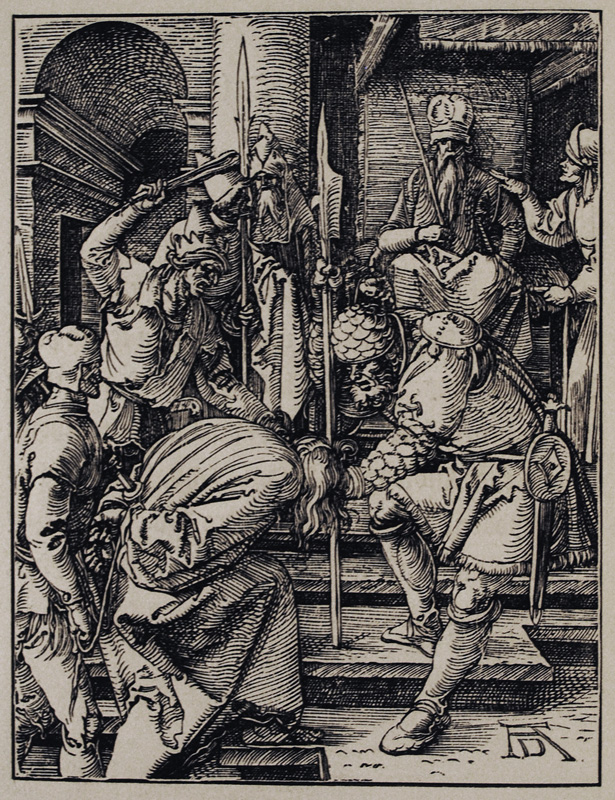 |
|
Albrecht Durer (Nuremburg, 1471-1528), Christ before Annas (B. 28, S. 113, Meder 137). Original woodcut, c. 1508-09. Strauss points out that this subject is unique to The Small Passion and is not included in any of Dürer's other versions of The Passion. Strauss also suggests that in picturing four 'presentations' in The Small Passion, Dürer follws the tradition pf Passion plays, where Christ is invariably taken before Annas, Caisphas, Pilate, and Herod, in this order. In 1844 plaster casts were made from Dürer's original woodblocks for the Small Woodcut Passion, which had just been acquired by the British Museum. From these casts, metal plates were made and a small edition produced. Our impression is from this edition. Image size: 127x95mm. Price: Please call or email for current pricing information.
|
|
|
|
|
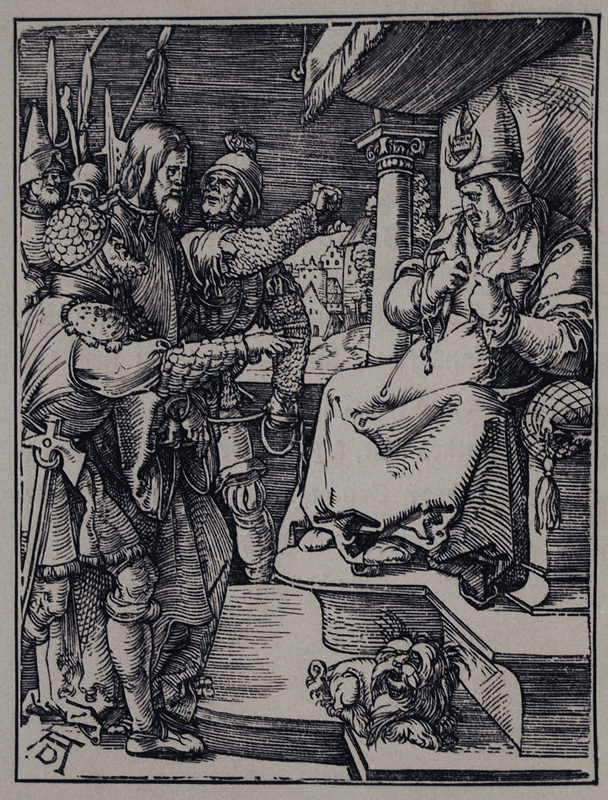 |
|
Albrecht Durer (Nuremburg, 1471-1528), Christ before Caiaphas (B. 29, S. 114, Meder 138). Original woodcut, c. 1508-09. Strauss notes that Caiaphas, the high priest who had prophesied that Christ would die for his people (John 11:51), here is shown tearing his clothes in feigned indignation upon learning of Christ's "blaspemy" by having answered in the affirmative that he was indeed the Son of God (Matthew 26:65; Mark 14:63; Luke 22:71)." Strauss also notes that Caiaphas's theatrics are chief focus of Dürer's presntation. Heller notes that copies of this scene exist by Master GS, Marcantonio Raimondi, Virgil Solis, Mommard, Waesberg, and others. In 1844 plaster casts were made from Dürer's original woodblocks for the Small Woodcut Passion, which had just been acquired by the British Museum. From these casts, metal plates were made and a small edition produced. Our impression is from this edition. Image size: 127x97mm. Price: Please call or email for current pricing information.
|
|
|
|
|
|
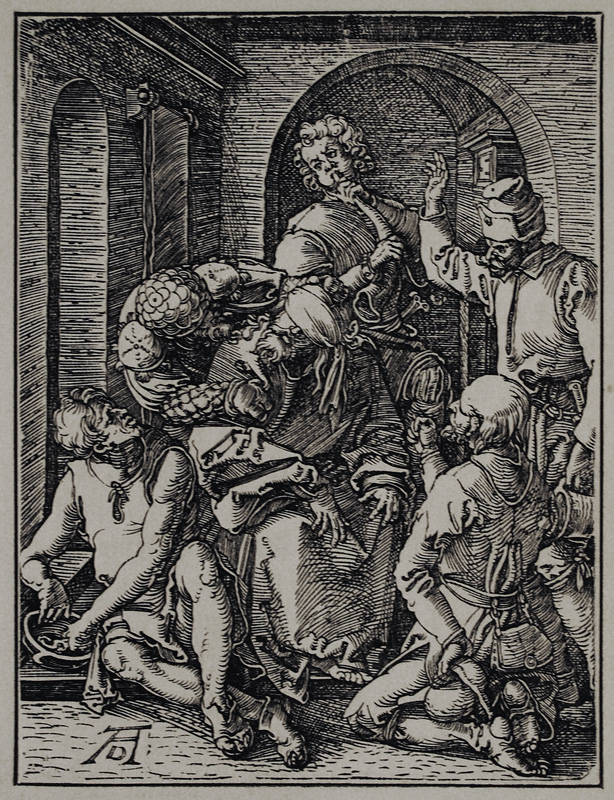 |
|
Albrecht Durer (Nuremburg, 1471-1528), The Mocking of Christ (B. 30, S. 115, Meder 139). Original woodcut, c. 1508-09. Strauss points out that here follows Mark 14:65: "And some began to spit on him, and to cover his face, and to buffet, and to say unto him, 'Prophesy.' And the guards dd strike him with the palms of their hands." This scene only occurs in the Small Passion. Heller notes that copies of this scene exist by Master GS, Marcantonio Raimondi, Virgil Solis, Mommard, Waesberg, and others. In 1844 plaster casts were made from Dürer's original woodblocks for the Small Woodcut Passion, which had just been acquired by the British Museum. From these casts, metal plates were made and a small edition produced. Our impression is from this edition. Image size: 127x97mm. Price: Please call or email for current pricing information.
|
|
|
|
|
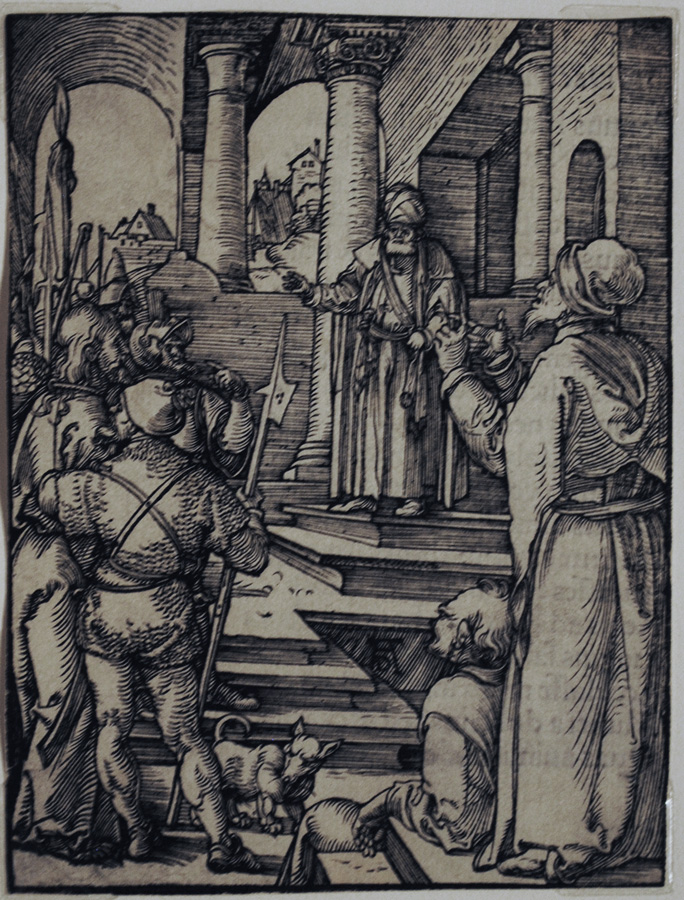 |
|
Albrecht Durer (Nuremburg, 1471-1528), Jesus taken to Pilate (B. 31, S. 116, Meder 140). Original woodcut, 1508-09. Our impression was published in the 1511 Latin book edition. It is a very good impression with strong contrasts and no sign of wear. It has been trimmed on the border line with part of the border line preserved all around. Strauss observed that "the complicated architecture, the schematic presentation, and especially the disproportionate size of the figures set this sheet apart from most of the others in the series. . . . The gabled structures, in this instance, are more reminiscent of Nuremberg than of Jerusalem" (p. 362). Heller notes that copies of this scene exist by Master GS, Marcantonio Raimondi, Virgil Solis, Mommard, Waesberg, and others. Image size: 128x97mm. Price: Please call or email for current pricing information.
|
|
|
|
|
|
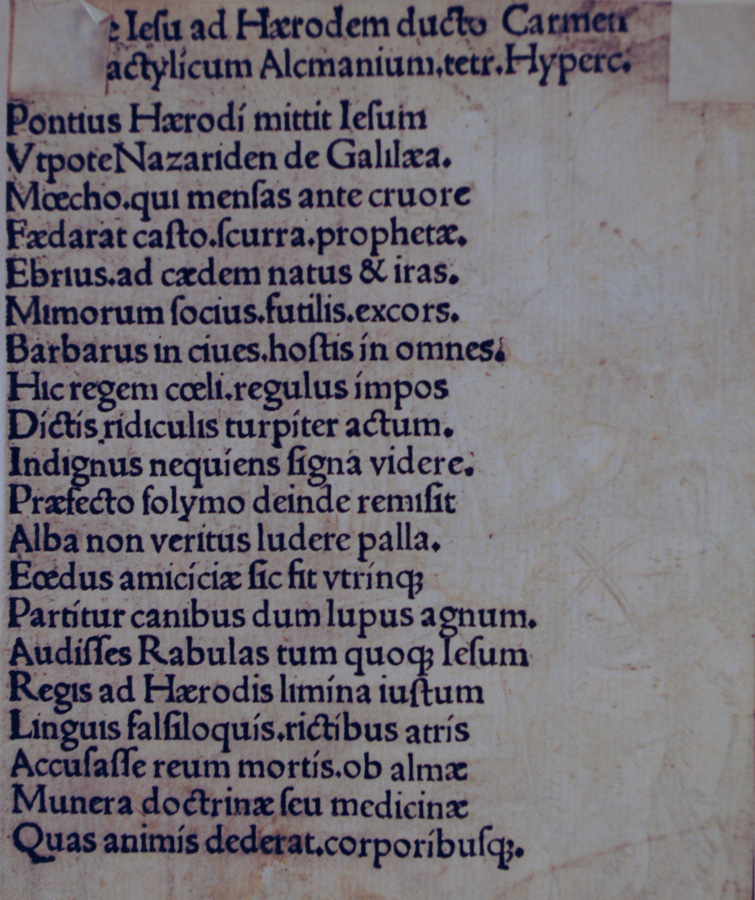 |
|
Albrecht Durer (Nuremburg, 1471-1528), Jesus taken to Pilate (B. 31, S. 116, Meder 140), Verso. Original woodcut, 1508-09. A superb, dark, and well-inked impression from the first 1511 book edition with the Latin text on the verso. From the 1511 first edition of the Small Woodcut Passion with verses on the verso by Benedictus Chelidonius. The text relates to the woodcut that follows the Jesus taken to Pilate, Christ before Herod. The text is only to be found in the 1511 edition of the Small Woodcut Passion.
|
|
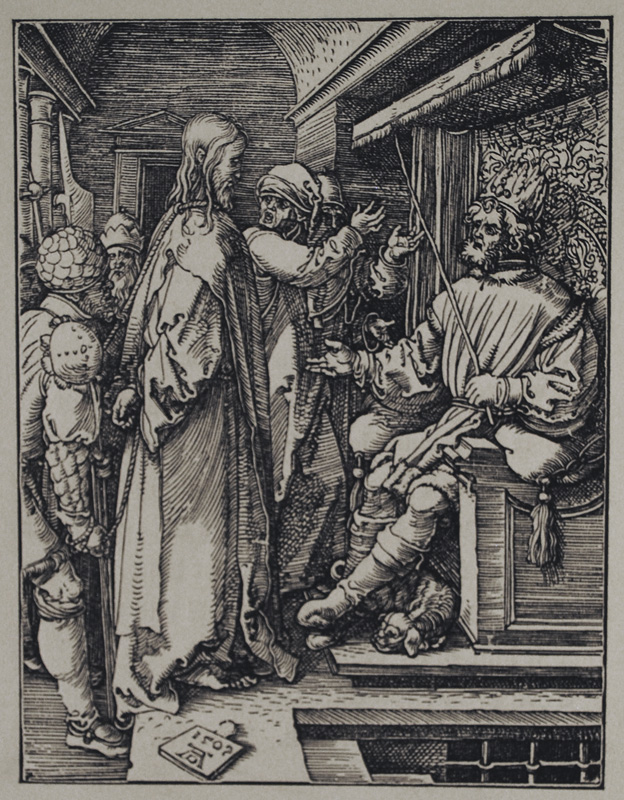 |
|
|
|
|
Albrecht Durer (Nuremburg, 1471-1528), Christ before Herod (B. 32, S. 117, M. 141) Original woodcut, dated 1509 in the block for the Small Passion. Upon learning that Chirst came from Galilee, Pilate sends him to Herod, who had jurisdiction over that part of the country. As Luke describes it, "And when Herod saw Jesus he was exceedingly glad; for he had been desious to see him for a long time, because he had heard many things about him, and he hoped to have seen some miracle done by him. Then he questioned him [Jesus] in many words but he [Jesus] answered him nothing." Heller notes that copies of this scene exist by Master GS, Marcantonio Raimondi, Virgil Solis, Mommard, Waesberg, and others. In 1844 plaster casts were made from Dürer's original woodblocks for the Small Woodcut Passion, which had just been acquired by the British Museum. From these casts, metal plates were made and a small edition produced. Our impression is from this edition. Image size: 127x97mm. Price: Please call or email for current pricing information.
|
|
|
|
|
|
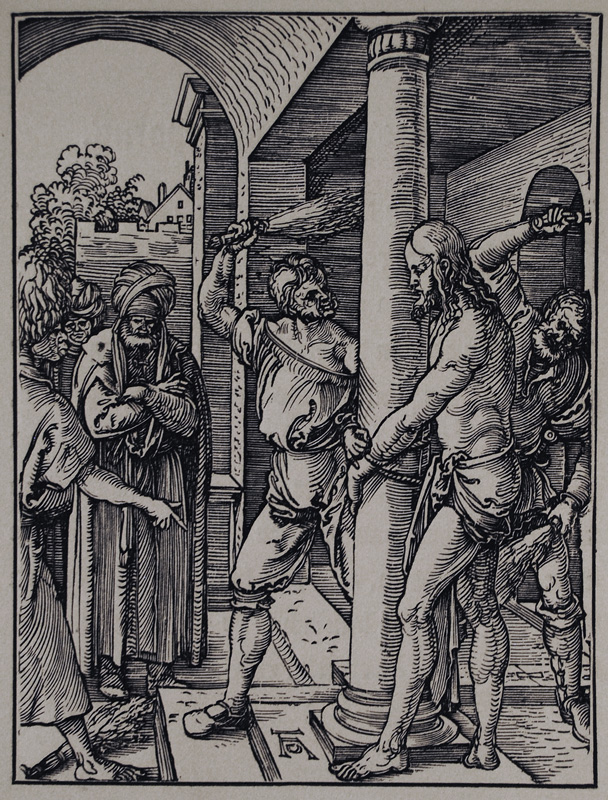 |
|
Albrecht Durer (Nuremburg, 1471-1528), The Flagellation (B. 33, S. 118, M. 142) Original woodcut, c. 1509 for the Small Passion. Heller notes that copies of this scene exist by Master GS, Marcantonio Raimondi, Virgil Solis, Mommard, Waesberg, and others. In 1844 plaster casts were made from Dürer's original woodblocks for the Small Woodcut Passion, which had just been acquired by the British Museum. From these casts, metal plates were made and a small edition produced. Our impression is from this edition. Image size: 127x97mm. Price: Please call or email for current pricing information.
|
|
|
|
|
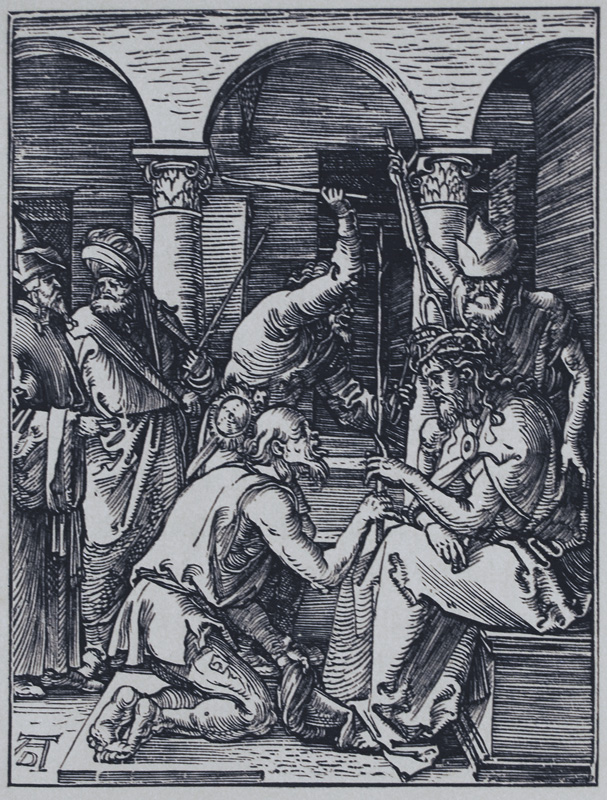 |
|
Albrecht Durer (Nuremburg, 1471-1528), Christ Crowned with Thorns (B. 34, S. 119, M. 143). Original woodcut, c. 1509 for the Small Passion. Strauss notes that Caiaphas and Herod are observing at left. The man kneeling before Jesus is presenting him with a sapling instead of a scepter, but, as Mathhew observes, from it "another cross may grow" (Matthew 27:29) for the future redemption of man. As Panofsky suggests with reference to the Frontispiece of the Large Passion, "Dürer did not intend to illustrate any specific event in the life of Christ on earth . . . but [it] becomes for us a vision of the eternal Christ Who has completed His Passion on earth and yet continues to be tortured by the sins of mankind" ; the question is how much does this approach play out here as well? Heller notes that copies of this scene exist by Master GS, Marcantonio Raimondi, Virgil Solis, Mommard, Waesberg, and others. In 1844 plaster casts were made from Dürer's original woodblocks for the Small Woodcut Passion, which had just been acquired by the British Museum. From these casts, metal plates were made and a small edition produced. Our impression is from this edition. Image size: 127x97mm. Price: Please call or email for current pricing information.
|
|
|
|
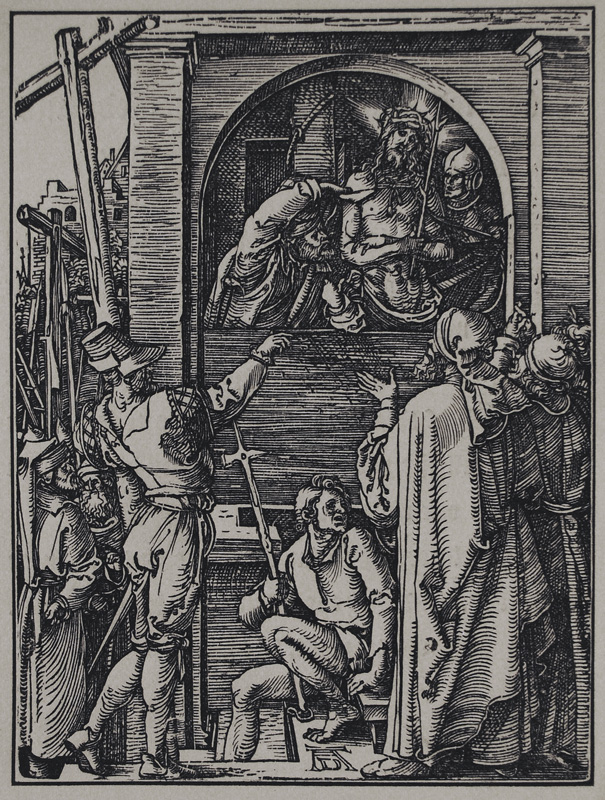 |
|
Albrecht Durer (Nuremburg, 1471-1528), Ecce Homo / Behold the Man! (B. 35, S. 120, M. 144). Original woodcut, c. 1509 for the Small Passion. Strauss notes that Pilate is lifting Jesus garment in an unsuccesful appeal for compassion from the viewers. Most of the space in this piece is given over to the building in whose window Jesus, Pilate, and a guard stand; to the left, we see the procession to Golgotha already forming with a ladder and two unoccupied crosses visible. Heller notes that copies of this scene exist by Master GS, Marcantonio Raimondi, Lambert Hopfer, Martino Rota, Virgil Solis, Mommard, Waesberg, and others. In 1844 plaster casts were made from Dürer's original woodblocks for the Small Woodcut Passion, which had just been acquired by the British Museum. From these casts, metal plates were made and a small edition produced. Our impression is from this edition. Image size: 127x97mm. Price: Please call or email for current pricing information.
|
|
|
|
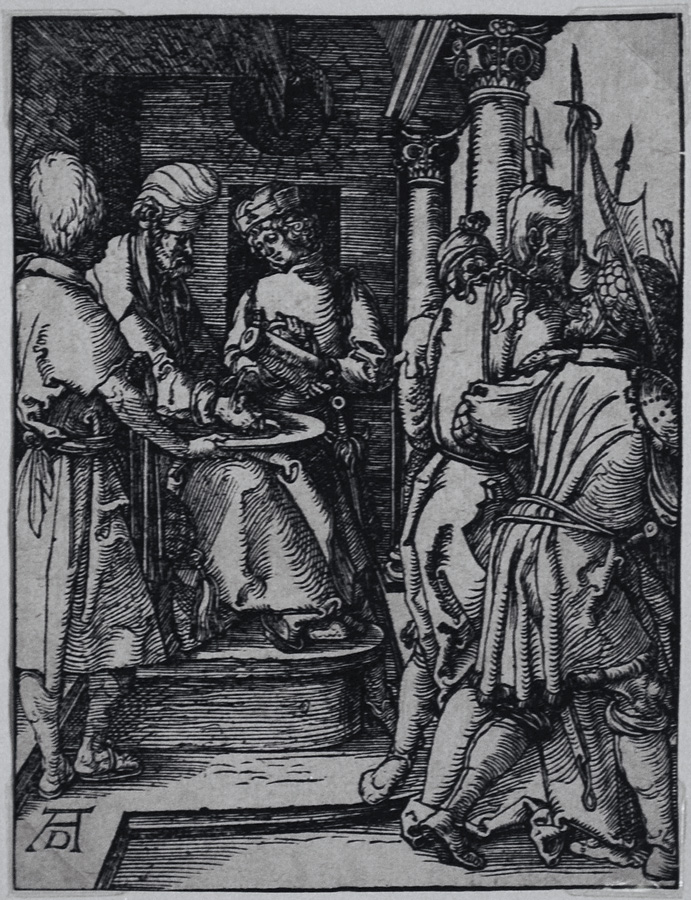 |
|
Albrecht Durer (Nuremburg, 1471-1528), Pilate wasshing his hands (B. 36, S. 121, M. 145) Original woodcut, c. 1509 for the Small Passion. A very good well-inked proof before the 1511 Latin text edition with borders all around (though slightly trimmed), with strong contrasts and little or no sign of wear. We see two separate actions here: Pilate is washing his hands to signify that he has finished with Jesus; Jesus, his back to Pilate, is being led away to be crucified. Meder describes the proofs before the 1511 edition as "superbly beautiful." The gap in the bottom center seen on impressions of this work in the 1511 Latin text edition has not yet occurred. A very powerful and dramatic piece. Image size: 129x97mm. Price: Please call or email for current pricing information.
|
|
|
|
Spaightwood Galleries, Inc.
To purchase, call us at 1-800-809-3343 (1-508-529-2511 in Upton MA & vicinity) or send an email to spaightwood@gmail.com.
We accept AmericanExpress, DiscoverCard, MasterCard, and Visa.
We also accept wire transfers and paypal.
For directions and visiting information, please call. We are, of course, always available over the web and by telephone (see above for contact information). Click the following for links to past shows and artists. For a visual tour of the gallery, please click here. For information about Andy Weiner and Sonja Hansard-Weiner, please click here. For a list of special offers currently available, see Specials.
All works are sold with an unconditional guarantee of authenticity (as described in our website listing).
Go back to the top of this page.
Visiting hours: Saturday 10:00 am to 5:00 pm and Sunday noon to 6:00 pm and other times by arrangement.
Please call to confirm your visit. Browsers and guests are welcome.
|
|
|
|
|
|
|
|
|
|
|
|
|
|
|
|
|
|
|
|
|
|
|
|
|
|
|
|
|
|
|
|
|
|
|
|
|
















